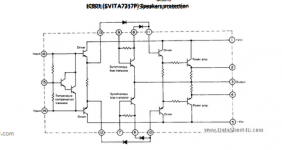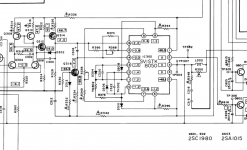Hey folks,
So I'm working on one of these for a friend. One channel was dead and I diagnosed it down to the STK8050 on that channel plus D308 which is an OA90 germanium diode.
I have a few STK8050s, so I have replaced the dead one. Unfortunately I do not have any OA90 or suitable germanium equivalents. I just have 1N0007s. I fitted one to test that I'd correctly diagnosed the problem and sure enough it's working and sounds great (and the same, to my ears) through both channels. However I don't know if there's any long term issues with leaving this substitution in the amp. Obviously it has a higher voltage drop than the OA90.
The issue is, my friend wants me to just leave it with the 1N4007 as he is moving in two days with the amp and another diode won't arrive in time. Basically I want to know whether to
1. Insist that he leaves it with me until i've got a germanium in and then courier it or something
2. tell him it will be fine for now but he should get it swapped out at some point after he moves
3. tell him it will be fine long term as long as he doesn't perceive any negative change to the sound
Can someone advise?
Many thanks.
So I'm working on one of these for a friend. One channel was dead and I diagnosed it down to the STK8050 on that channel plus D308 which is an OA90 germanium diode.
I have a few STK8050s, so I have replaced the dead one. Unfortunately I do not have any OA90 or suitable germanium equivalents. I just have 1N0007s. I fitted one to test that I'd correctly diagnosed the problem and sure enough it's working and sounds great (and the same, to my ears) through both channels. However I don't know if there's any long term issues with leaving this substitution in the amp. Obviously it has a higher voltage drop than the OA90.
The issue is, my friend wants me to just leave it with the 1N4007 as he is moving in two days with the amp and another diode won't arrive in time. Basically I want to know whether to
1. Insist that he leaves it with me until i've got a germanium in and then courier it or something
2. tell him it will be fine for now but he should get it swapped out at some point after he moves
3. tell him it will be fine long term as long as he doesn't perceive any negative change to the sound
Can someone advise?
Many thanks.
1N4148?
Or a Schottky diode for better sound
New germanium are hard to find.
If it works without noticeable difference, let it be.
The voltage drop is 0.7 for silicon, 0.3 for Germanium, and as low as 0.2 for some Sckottky types.
Schottky are very common in SMPS circuits.
If you feel the 0.4 volts difference will cause problems, go ahead, put a Schottky there.
Or a Schottky diode for better sound
New germanium are hard to find.
If it works without noticeable difference, let it be.
The voltage drop is 0.7 for silicon, 0.3 for Germanium, and as low as 0.2 for some Sckottky types.
Schottky are very common in SMPS circuits.
If you feel the 0.4 volts difference will cause problems, go ahead, put a Schottky there.
Last edited:
Check with a VU meter or an analog meter on 10 or 50 V AC range at the speaker outputs.
If there is no difference, leave it.
Purists and faddists insist Schottky give better results in AC power supplies at mains frequencies, which is nonsense.
If the diode is seeing frequencies into treble, well maybe a Schottky may work better, and the 4148 too has a higher frequency rating than the 4007 I think.
But if it is in a low frequency part of the circuit where it is handling 3 or 12 volts, the extra drop is insignificant.
If there is no difference, leave it.
Purists and faddists insist Schottky give better results in AC power supplies at mains frequencies, which is nonsense.
If the diode is seeing frequencies into treble, well maybe a Schottky may work better, and the 4148 too has a higher frequency rating than the 4007 I think.
But if it is in a low frequency part of the circuit where it is handling 3 or 12 volts, the extra drop is insignificant.
Thanks for all the responses folks.
According to the STK8050 datasheet - the diode anode connects to pin 8, which is connected to the collector of a bias transistor. The cathode connects to pin 11 which is connected to the base of a driver transistor
As for the voltage drop, comparing with the other channel which still has an intact germanium transistor...
D308 ANODE - 1.10vdc (original also 1.10vdc)
D308 CATHODE - 0.60v (original is 0.89v)
NAreshBrd - I can confirm that AC readings at speaker outputs is identical between channels.
I don't have a 1n4148 lying around i'm afraid!
According to the STK8050 datasheet - the diode anode connects to pin 8, which is connected to the collector of a bias transistor. The cathode connects to pin 11 which is connected to the base of a driver transistor
As for the voltage drop, comparing with the other channel which still has an intact germanium transistor...
D308 ANODE - 1.10vdc (original also 1.10vdc)
D308 CATHODE - 0.60v (original is 0.89v)
NAreshBrd - I can confirm that AC readings at speaker outputs is identical between channels.
I don't have a 1n4148 lying around i'm afraid!
These diodes control/affect (to some degree) idle current.
So the drop voltage will matter.
Maybe it'll be good enough to re-adjust idle current after replacing the diode.
You may also lose symmetry between upper/lower swing..
So the drop voltage will matter.
Maybe it'll be good enough to re-adjust idle current after replacing the diode.
You may also lose symmetry between upper/lower swing..
Attachments
Last edited:
1n4148 is not gonna make much difference as far as voltage drop goes.
Original germanium diode has little bit over 200mV drop.
None of silicon diodes gonna be close to it.
1n4148 is better than rectifier diode because it's faster, but the main problem here is
voltage drop, not speed.
Here is the diode you need:
New Old Stock OA90 Germanium Signal Diode | eBay
But I suspect you could use any germanium small glass diode.
1N8xx, NTE109. Plenty of them on Ebay.
Original germanium diode has little bit over 200mV drop.
None of silicon diodes gonna be close to it.
1n4148 is better than rectifier diode because it's faster, but the main problem here is
voltage drop, not speed.
Here is the diode you need:
New Old Stock OA90 Germanium Signal Diode | eBay
But I suspect you could use any germanium small glass diode.
1N8xx, NTE109. Plenty of them on Ebay.
>What about the 1N34A?
Measure the voltage drop on it (if you have it on hands).
If it's approx 200mV +/- 30 (at 1-5mA) it's ok.
Datasheet is inconclusive, it only says that MAX drop is 1V.
Exactly the same as voltage from OA90s datasheet.
But what it the typical drop? It always depends on current.
Some sources say that "The 1N34A will conduct 0.5mA at about 0.3V."
which might be ok here.
Since they are all germanium, and the max drop in both datasheets shows the same 1V, most likely it will fit just fine.
Put it in, and measure, it won't be worse than silicon rectifier diode..
Measure the voltage drop on it (if you have it on hands).
If it's approx 200mV +/- 30 (at 1-5mA) it's ok.
Datasheet is inconclusive, it only says that MAX drop is 1V.
Exactly the same as voltage from OA90s datasheet.
But what it the typical drop? It always depends on current.
Some sources say that "The 1N34A will conduct 0.5mA at about 0.3V."
which might be ok here.
Since they are all germanium, and the max drop in both datasheets shows the same 1V, most likely it will fit just fine.
Put it in, and measure, it won't be worse than silicon rectifier diode..
- Status
- This old topic is closed. If you want to reopen this topic, contact a moderator using the "Report Post" button.
- Home
- Amplifiers
- Solid State
- Technics Su-V4 Repair

